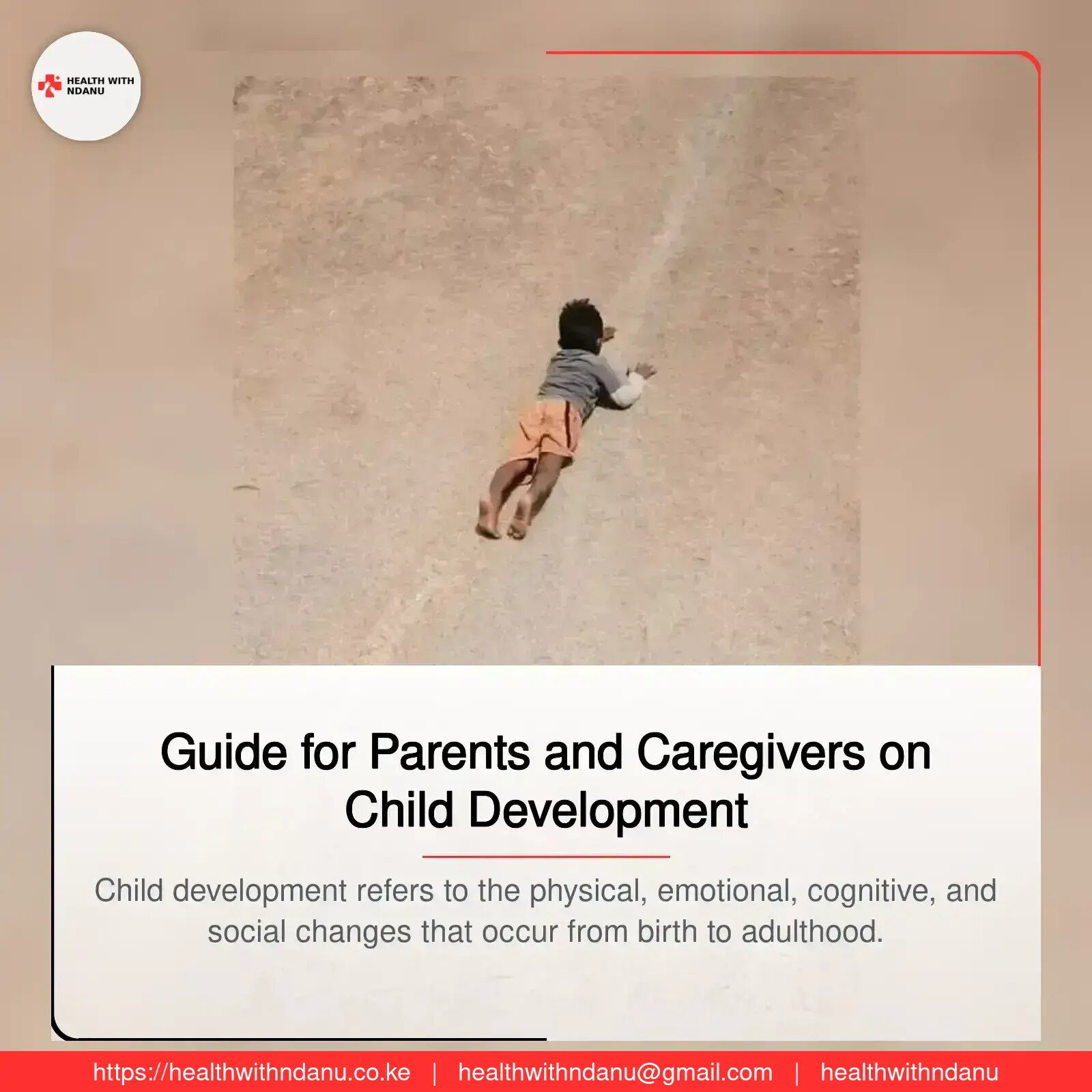Guide for Parents and Caregivers on Child Development
- by Diana Ndanu
- 18 January, 2025
- 0 Comments
- 6 Mins



Introduction
Child development is an exciting journey filled with milestones, challenges, and incredible growth. From a baby's first smile to a teenager's blossoming independence, every stage of development brings new adventures. But how do you ensure your child grows up healthy, happy, and well-rounded? This article will explore the stages of child development, what to expect, and how you can support your child every step of the way.
What is Child Development?
Child development refers to the physical, emotional, cognitive, and social changes that occur from birth to adulthood. It’s a dynamic process influenced by genetics, environment, and experiences. Understanding these stages can help parents and caregivers provide the support children need to thrive.
The Stages of Child Development
Child development can be divided into key stages, each with unique milestones:
1. Infancy (0-12 months)
During this stage, babies experience rapid physical and sensory development.
Key Milestones:
- Physical: Holding up their head, rolling over, sitting, crawling, and eventually walking.
- Cognitive: Recognizing faces, responding to sounds, and exploring the world through touch.
- Social and Emotional: Smiling, cooing, and forming bonds with caregivers.
How to Support Your Baby:
- Provide plenty of tummy time to strengthen muscles.
- Respond to their cries to build trust and emotional security.
- Talk, sing, and read to stimulate their cognitive development.
2. Early Childhood (1-3 years)
This is the age of exploration, curiosity, and rapid learning.
Key Milestones:
- Physical: Walking, running, climbing, and improved hand-eye coordination.
- Cognitive: Developing problem-solving skills, learning new words, and starting to count.
- Social and Emotional: Expressing feelings, playing with others, and showing independence.
How to Support Your Toddler:
- Encourage active play to develop motor skills.
- Read daily to boost language development.
- Set clear boundaries while allowing them to explore their independence.
3. Preschool Age (3-5 years)
At this stage, children become more social and imaginative.
Key Milestones:
- Physical: Improved coordination for activities like hopping, skipping, and drawing.
- Cognitive: Asking questions, recognizing letters and numbers, and understanding basic concepts.
- Social and Emotional: Making friends, sharing, and understanding others' feelings.
How to Support Your Preschooler:
- Encourage pretend play to develop creativity and problem-solving skills.
- Introduce educational games and puzzles.
- Teach social skills like sharing and taking turns.
4. Middle Childhood (6-12 years)
This stage involves significant academic, social, and emotional growth.
Key Milestones:
- Physical: Steady growth, improved athletic abilities, and mastering complex physical activities.
- Cognitive: Logical thinking, improved memory, and academic achievements.
- Social and Emotional: Developing self-esteem, managing emotions, and forming stronger friendships.
How to Support Your Child:
- Encourage participation in extracurricular activities.
- Provide a structured routine for homework and play.
- Talk openly about feelings and teach problem-solving skills.
5. Adolescence (13-18 years)
Adolescence is a time of identity exploration and increased independence.
Key Milestones:
- Physical: Puberty and rapid physical changes.
- Cognitive: Abstract thinking, decision-making, and planning for the future.
- Social and Emotional: Forming deeper relationships and developing a sense of self.
How to Support Your Teenager:
- Respect their need for independence while setting boundaries.
- Encourage open communication about emotions and challenges.
- Support their interests and help them explore career or academic goals.
Factors Influencing Child Development
1. Genetics: Determines physical traits and predispositions.
2. Environment: Includes family, community, and cultural influences.
3. Nutrition: A balanced diet is crucial for physical and cognitive development.
4. Education: Early learning experiences shape future academic success.
5. Social Interactions: Peer relationships teach cooperation, empathy, and conflict resolution.
The Role of Parents and Caregivers in Child Development
As a parent or caregiver, you play a pivotal role in your child’s growth. Here’s how you can make a difference:
1. Provide a Safe Environment: Childproof your home and create a space where they can explore freely.
2. Be Present: Spend quality time together, whether it’s reading, playing, or simply talking.
3. Encourage Curiosity: Answer their questions and nurture their natural curiosity.
4. Promote Healthy Habits: Encourage good nutrition, regular exercise, and adequate sleep.
5. Model Positive Behavior: Children learn by watching, so demonstrate kindness, patience, and resilience.
Common Challenges in Child Development
While most children follow a general pattern of development, some may face challenges, including:
1. Developmental Delays: Difficulty meeting milestones in speech, motor skills, or social interactions.
2. Behavioral Issues: Problems with attention, aggression, or emotional regulation.
3. Learning Disabilities: Struggles with reading, writing, or math skills.
4. Social Challenges: Difficulty forming friendships or understanding social cues.
What to Do:
- Observe your child’s behavior and development.
- Consult a pediatrician or developmental specialist if you notice delays.
- Provide additional support through therapy, tutoring, or specialized programs.
The Importance of Play in Child Development
Play isn’t just fun—it’s essential for learning and growth.
Benefits of Play:
- Develops physical skills like coordination and balance.
- Enhances cognitive abilities through problem-solving and creativity.
- Builds social skills by encouraging teamwork and communication.
- Supports emotional health by reducing stress and boosting confidence.
Types of Play:
- Free Play: Letting kids explore and create on their own.
- Structured Play: Activities like sports or board games with rules.
- Imaginative Play: Role-playing and make-believe games.
Nurturing Emotional Intelligence in Children
Emotional intelligence (EQ) is the ability to understand and manage emotions. Teaching this skill early sets children up for success in relationships and life.
How to Build EQ:
- Label Emotions: Help them identify their feelings.
- Teach Empathy: Encourage them to consider others’ perspectives.
- Model Emotional Regulation: Show them how to handle frustration or disappointment calmly.
- Praise Effort, Not Outcome: Build resilience by focusing on their hard work rather than the result.
Child Development and Technology
In today’s digital age, technology is a big part of children’s lives. While it offers educational opportunities, excessive screen time can impact development.
Tips for Managing Screen Time:
- Set time limits for recreational screen use.
- Encourage tech-free family activities.
- Choose educational apps and programs.
- Teach responsible online behavior and safety.
Conclusion: Celebrating Every Stage of Child Development
Child development is a fascinating and rewarding journey. By understanding the stages of growth and providing a nurturing environment, you can help your child reach their full potential.
Remember, every child is unique, and development doesn’t always follow a strict timeline. Celebrate their progress, support their challenges, and enjoy the incredible privilege of watching them grow.
Healthy, happy children are the foundation of a brighter future—and it all starts with informed and loving caregivers like you and me.
Got Your Own Experience? Share with us
Popular Categories
Mablogu Zinazobambwa Sana
Daily Newsletter
Get all the top stories from Blogs to keep track.



